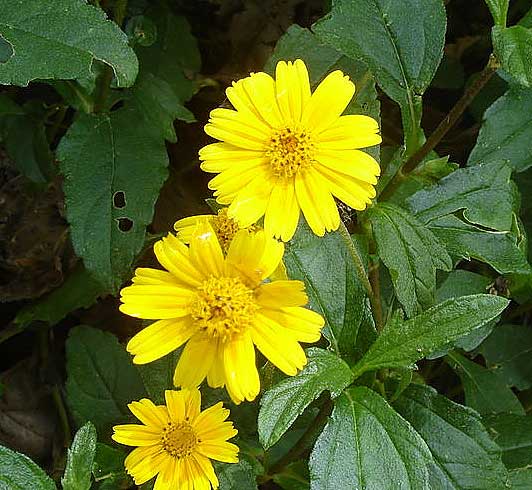
Sphagneticola trilobata (*)
Classification System: APG IV
Superregnum: Eukaryota
Regnum: Plantae
Cladus: Angiosperms
Cladus: Eudicots
Cladus: Core eudicots
Cladus: Asterids
Cladus: Campanulids
Ordo: Asterales
Familia: Asteraceae
Subfamilia: Asteroideae
Tribus: Heliantheae
Subtribus: Ecliptinae
Genus: Sphagneticola
Species: Sphagneticola trilobata
Name
Sphagneticola trilobata (L.) Pruski, Mem. New York Bot. Gard. 78: 114. 17 Dec 1996.
Synonyms
Basionym
Silphium trilobatum L.
Homotypic
Complaya trilobata (L.) Strother
Seruneum trilobatum (L.) Kuntze
Stemmodontia trilobata (L.) Small
Thelechitonia trilobata (L.) H.Rob. & Cuatrec.
Wedelia trilobata (L.) Hitchc.
Heterotypic
Acmella brasiliensis Spreng.
Acmella spilanthoides Cass.
Buphthalmum heterophyllum Willd. ex DC.
Buphthalmum procumbens Desf. ex Steud.
Buphthalmum repens Lam.
Buphthalmum strigosum Spreng.
Polymnia crenata Poir.
Seruneum paludosum (DC.) Kuntze
Sphagneticola ulei O.Hoffm.
Wedelia brasiliensis (Spreng.) S.F.Blake
Wedelia carnosa Pers.
Wedelia crenata Rich.
Wedelia paludicola Poepp.
Wedelia paludosa DC.
Wedelia pedunculata Mart. ex Colla
Wedelia tannensis Endl.
Wedelia trilobata var. hirtella O.E.Schulz
Distribution
Native distribution areas:
References
Queensland Government:Singapore daisy
Prasad, A.V. 2013: The diversity of arthropods associated with the exotic creeping daisy (Sphagneticola trilobata) in Suva, Fiji Islands. Entomologist's monthly magazine 149(1790-92): 155-161. [not seen] Reference page.
Links
International Plant Names Index. 2018. Sphagneticola trilobata. Published online. Accessed: Feb. 02 2018.
The Plant List 2013. Sphagneticola trilobata in The Plant List Version 1.1. Published on the internet. Accessed: 2018 Feb. 02.
Tropicos.org 2018. Sphagneticola trilobata. Missouri Botanical Garden. Published on the internet. Accessed: 2018 Feb. 02.
Hassler, M. 2018. Sphagneticola trilobata. World Plants: Synonymic Checklists of the Vascular Plants of the World In: Roskovh, Y., Abucay, L., Orrell, T., Nicolson, D., Bailly, N., Kirk, P., Bourgoin, T., DeWalt, R.E., Decock, W., De Wever, A., Nieukerken, E. van, Zarucchi, J. & Penev, L., eds. 2018. Species 2000 & ITIS Catalogue of Life. Published on the internet. Accessed: 2018 Feb. 02. Reference page.
USDA, ARS, Germplasm Resources Information Network. Sphagneticola trilobata in the Germplasm Resources Information Network (GRIN), U.S. Department of Agriculture Agricultural Research Service. Accessed: 07-Oct-06.
Vernacular names
English: Bay Biscayne creeping-oxeye, Singapore daisy
español: Jampana Playera, Manzanilla amarilla, Manzanilla de playa, Margarita del pasto. Romerillo
suomi: Hippusilmä
Sphagneticola trilobata, commonly known as the Bay Biscayne creeping-oxeye,[3] Singapore daisy, creeping-oxeye, trailing daisy, and wedelia,[4][5] is a plant in the Heliantheae tribe of the Asteraceae (sunflower) family. It is native to Mexico, Central America, and the Caribbean, but now grows throughout the Neotropics. It is widely cultivated as an ornamental groundcover.[6]
Description
Spreading, mat-forming perennial herb up to 30 cm in height. Has rounded stems up to 40 cm long, rooting at nodes and with the flowering stems ascending. Leaves are fleshy, hairy, 4–9 cm long and 2–5 cm wide, serrate or irregularly toothed, normally with pairs of lateral lobes, and dark green above and lighter green below. Peduncles are 3–10 cm long; involucres are campanulate to hemispherical, about 1 cm high; chaffy bracts are lanceolate, rigid. The flowers are bright yellow ray florets of about 8-13 per head, rays are 6–15 mm long; disk-corollas 4–5 mm long. The pappus is a crown of short fimbriate scales. The seeds are tuberculate achenes, 4–5 mm long. Propagation is mostly vegetatively as seeds are usually not fertile.[7]
Habitat
It has a very wide ecological tolerance range, but grows best in sunny areas with well-drained, moist soil at low elevations.[8]
Invasive Species
Sphagneticola trilobata is listed in the IUCN's “List of the world's 100 worst invasive species”.[9] It is spread by people as an ornamental or groundcover that is planted in gardens, and then it is spread into surrounding areas by dumping of garden waste. It spreads vegetatively, not by seed. It rapidly forms a dense ground cover, crowding away and preventing other plant species from regenerating. This species is widely available as an ornamental and is therefore likely to spread further.
It is a noxious weed in agricultural land, along roadsides urban waste places and other disturbed sites. It is also invasive along streams, canals, along the borders of mangrove swamps and in coastal vegetation.
It is widespread as an invasive species on the Pacific Islands, Hong Kong, South Africa, Australia,, Indonesia, and Sri Lanka. [10]
See also
List of Asteraceae genera
References
"Taxon: Sphagneticola trilobata (L.) Pruski". Germplasm Resources Information Network. United States Department of Agriculture. 2000-11-28. Archived from the original on 2011-06-29. Retrieved 2011-02-16.
"Sphagneticola trilobata (herb)". Global Invasive Species Database. Invasive Species Specialist Group. 2007-05-31. Retrieved 2010-06-07.
USDA, NRCS (n.d.). "Sphagneticola trilobata". The PLANTS Database (plants.usda.gov). Greensboro, North Carolina: National Plant Data Team. Retrieved 25 November 2015.
”Sphagneticola trilobata” , Pacific Island Ecosystems at Risk (PIER) website, http://www.hear.org/pier/species/sphagneticola_trilobata.htm
"Sphagneticola trilobata". Integrated Taxonomic Information System. Retrieved 2011-02-16.
”Sphagneticola trilobata (herb)”, Global Invasive Species Database website, at http://www.issg.org/database/species/ecology.asp?si=44
”Sphagneticola trilobata” , Pacific Island Ecosystems at Risk (PIER) website, http://www.hear.org/pier/species/sphagneticola_trilobata.htm Lalith Gunasekera, Invasive Plants: A guide to the identification of the most invasive plants of Sri Lanka, Colombo 2009, p. 117–118.
”Sphagneticola trilobata (herb)”, Global Invasive Species Database, at [1] ” Sphagneticola trilobata (wedelia)” Invasive Species Compendium website, at http://www.cabi.org/isc/?compid=5&dsid=56714&loadmodule=datasheet&page=481&site=144
http://www.iucngisd.org/gisd/pdf/100English.pdf
”Sphagneticola trilobata” , Pacific Island Ecosystems at Risk (PIER) website, http://www.hear.org/pier/species/sphagneticola_trilobata.htm ”Sphagneticola trilobata (herb)”, Global Invasive Species Database website, at http://www.issg.org/database/species/ecology.asp?si=44 ”Singapore daisy”, Invasive Species South Africa website, at http://www.invasives.org.za/invasive-species/item/345-singapore-daisy-sphagneticola-trilobata.html Lalith Gunasekera, Invasive Plants: A guide to the identification of the most invasive plants of Sri Lanka, Colombo 2009, p. 117–118. ” Sphagneticola trilobata (wedelia)” Invasive Species Compendium website, at http://www.cabi.org/isc/?compid=5&dsid=56714&loadmodule=datasheet&page=481&site=144
Further reading
plants.usda.gov
hear.org
http://www.austrop.org.au/_docs/msmTrialPaper.pdf
Retrieved from "http://en.wikipedia.org/"
All text is available under the terms of the GNU Free Documentation License

